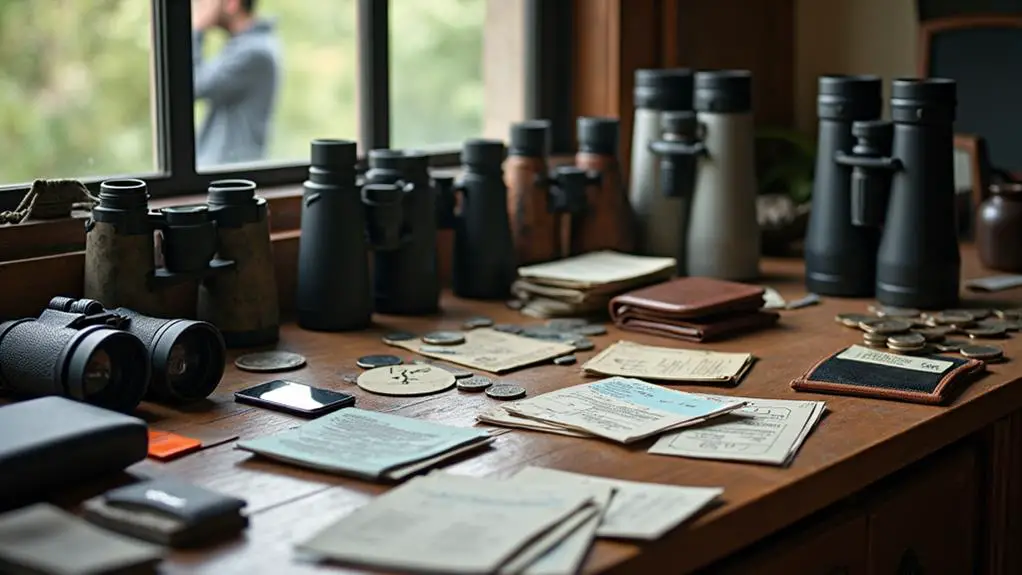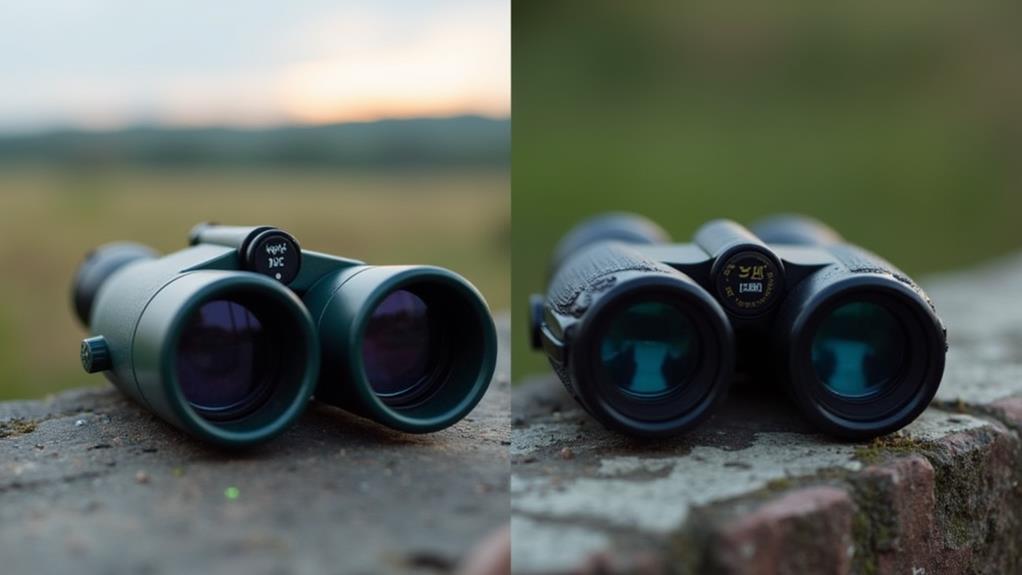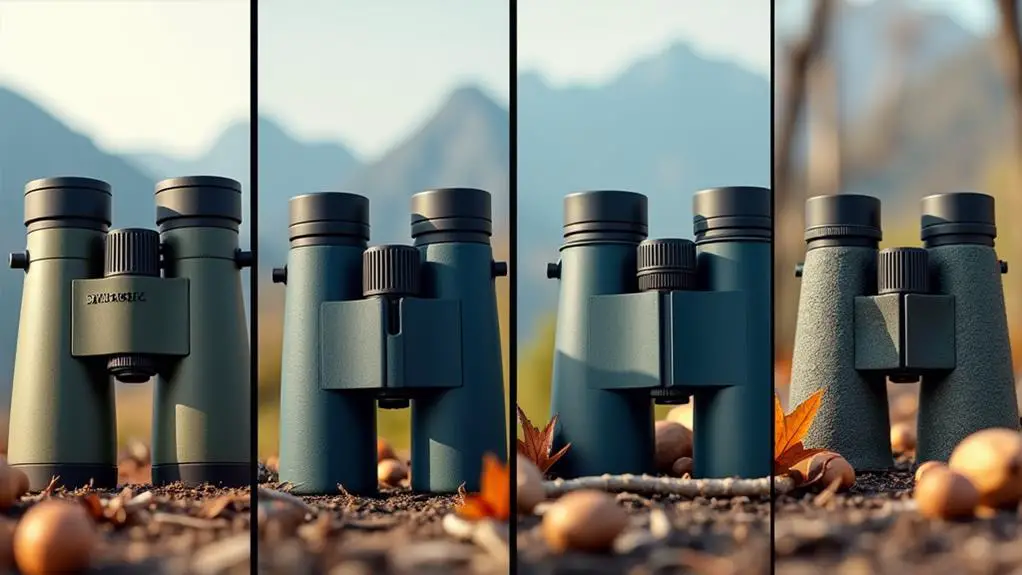When you're in the market for binoculars, it's easy to get overwhelmed by the numerous options available. You've probably asked yourself, "What's the right pair for me?" The answer lies in understanding your needs and priorities. You're about to make a crucial investment, and it's essential to get it right. By considering your budget, intended use, and must-have features, you'll be well on your way to finding the perfect binoculars. But, where do you start?
Key Takeaways
- Determine your budget to prioritize needs and find binoculars that balance quality, features, and brand within your price range.
- Prioritize optical quality over magnification, considering lens size, field of view, and clarity for the best viewing experience.
- Durable construction materials, coatings, and finishes ensure binoculars can withstand rough handling and harsh weather conditions.
- Adjustable eye relief, night vision capability, and customizable eyecups enhance the viewing experience, especially in low-light conditions.
- Consider specialized use cases, such as wildlife observation or outdoor sports, to choose binoculars with features tailored to your specific needs.
Determine Your Binoculars Budget

As you embark on selecting the perfect binoculars, determining your budget is the essential first step.
Binocular enthusiasts often overlook this crucial aspect, only to find themselves constrained by financial limitations. It's vital to set a realistic budget before diving into the world of binoculars.
Your budget will dictate the quality, features, and brand of binoculars you can afford.
Financial constraints can be a significant hurdle for enthusiasts, but they can also help you narrow down your options and make a more informed decision.
Consider how often you'll use your binoculars, the activities you'll be using them for, and the level of quality you're willing to compromise on.
A well-defined budget will help you prioritize your needs and make a more targeted search.
You may need to sacrifice certain features or brand names, but you'll be more likely to find a pair that meets your requirements.
Understanding Magnification and Zoom
Clarity of vision is the ultimate goal when selecting binoculars, and understanding magnification and zoom is crucial to achieving it.
You've likely seen binoculars advertised with impressive-sounding magnification numbers, but what do they really mean? Magnification refers to the degree to which an object is enlarged, but it's not the only factor in achieving clear vision.
In fact, high magnification can be a drawback if it exceeds the magnification limits of your binoculars' optical quality. This can result in a blurry, shaky image.
Zoom, on the other hand, allows you to adjust the magnification to suit your needs. However, be wary of zoom fatigue, which occurs when you're constantly adjusting the zoom to try to get a clear image.
This can lead to eye strain and fatigue. When choosing binoculars, look for a balance between magnification and optical quality. A higher magnification doesn't always mean better performance.
Consider your specific needs and priorities, and don't be swayed by exaggerated magnification claims. By understanding the relationship between magnification and zoom, you'll be better equipped to choose binoculars that deliver clear, crisp images.
Lens Size and Field of View

You'll often find binoculars categorized by their objective lens size, usually measured in millimeters. This measurement refers to the diameter of the front lens, which affects the amount of light that enters the binoculars.
A larger lens size allows more light to enter, resulting in better optical clarity and a brighter image. However, larger lenses also increase the weight and cost of the binoculars.
When choosing binoculars, consider the lens quality and the desired field of view.
A larger lens size typically provides a wider field of view, but may compromise on lens quality. Look for binoculars with high-quality lenses that balance size and optical clarity.
A good rule of thumb is to prioritize lens quality over lens size, as high-quality lenses can provide better optical clarity even at smaller sizes.
A wider field of view is ideal for observing moving objects or taking in scenic vistas.
However, it may require a larger lens size, which can add bulk to the binoculars.
Ultimately, you'll need to weigh the trade-offs between lens size, field of view, and optical clarity to find the right binoculars for your needs.
Material and Durability Matters
Beyond optical performance, the material and durability of your binoculars play a critical role in their overall usability and lifespan.
You'll want to consider the construction materials, coatings, and finishes that ensure your binoculars can withstand the elements and rough handling. Look for a rubber coating, which provides a secure grip and protects the binoculars from scratches and bumps.
A durable, waterproof housing is also essential for weather resistance. Check the IPX rating, which measures the binoculars' resistance to solid particles and water. A higher rating indicates better protection against the elements.
The type of material used for the housing and other components is also important. Polycarbonate, magnesium, or aluminum are common materials used in binocular construction, each offering varying levels of strength, durability, and weight.
Consider the environment you'll be using your binoculars in and choose materials that can withstand those conditions. Ultimately, the material and durability of your binoculars will impact their reliability and lifespan.
Additional Features to Consider

You'll also want to consider binoculars with adjustable eye relief to ensure a comfortable fit, especially if you wear glasses or have a unique facial structure.
Additionally, if you plan to use your binoculars in low-light conditions, look for models with night vision capability, which can greatly enhance your viewing experience.
Eye Relief Adjustment
When selecting binoculars, eye relief adjustment is a critical feature to consider, as it significantly impacts your viewing experience.
This feature allows you to customize the distance between your eyes and the binoculars' eyepieces, ensuring a comfortable and strain-free viewing experience.
Proper eye relief adjustment is essential for eye strain prevention.
If the eye relief is too short, you'll experience discomfort and fatigue, especially during extended use.
On the other hand, adjustable comfort ensures that you can use your binoculars without feeling cramped or restricted.
Look for binoculars with adjustable eyecups or retractable eyepieces that allow you to customize the eye relief to your specific needs.
This feature is particularly important for users who wear glasses or have unique facial structures.
Night Vision Capability
One crucial aspect to consider in your binocular selection is night vision capability, a feature that can significantly enhance your overall viewing experience, especially in low-light environments.
When stargazing or observing Dark Skies, having binoculars with night vision capability can make all the difference.
1. Generation: Look for binoculars with at least Gen 1 night vision, which amplifies available light up to 1,000 times.
Higher generations (Gen 2, Gen 3) offer better performance but are also more expensive.
2. Objective Lens Size: A larger objective lens (e.g., 50mm or larger) can gather more light, improving low-light performance.
3. Coatings and Lens Quality: High-quality lenses with anti-reflective coatings can minimize light loss and enhance image clarity in low-light conditions.
When evaluating night vision capability, consider your specific needs and the environments you'll be using your binoculars in.
Binoculars for Specific Activities
When choosing binoculars for specific activities, you'll want to consider the unique demands of your pursuit.
For hunting and wildlife observation, you'll prioritize close focus, ruggedness, and good low-light performance.
For outdoor and sports applications, you'll need binoculars that are waterproof, fog-proof, and can keep up with fast-moving action.
Hunting and Wildlife
Scan the terrain, and you'll quickly realize that hunting and wildlife observation require a unique set of binocular specifications.
You need binoculars that can keep up with your active lifestyle, providing clear views in various lighting conditions and rugged terrain.
When it comes to hunting and wildlife observation, you'll want to prioritize the following features:
- High magnification: Look for binoculars with a magnification power of 10x or 12x to get a closer view of your target.
- Wide field of view: A wider field of view (around 300-350 feet) allows you to track moving targets and observe wildlife behavior more effectively.
- Good low-light performance: Binoculars with good low-light performance, such as those with larger objective lenses or specialized coatings, will help you spot game in early morning or late evening hours.
Outdoor and Sports
As you shift your focus from hunting and wildlife observation to outdoor and sports activities, you'll find that your binocular needs change dramatically. Outdoor adventures and sports enthusiasts require binoculars that can keep up with their fast-paced activities.
| Feature | Recommended Spec |
|---|---|
| Magnification | 7x or 8x for a wider field of view |
| Objective Lens | 30mm to 42mm for better low-light performance |
| Weight | Under 20 oz for easy portability |
| Water Resistance | Waterproof and fog-proof for use in harsh weather |
| Close Focus | 6 ft or less for observing nearby objects |
When choosing binoculars for outdoor and sports activities, prioritize a wider field of view and better low-light performance. A magnification of 7x or 8x and an objective lens of 30mm to 42mm will allow you to track fast-moving objects and observe details in low-light conditions. Additionally, look for lightweight and water-resistant binoculars with a close focus of 6 ft or less to ensure you can observe nearby objects without any hassle.
Frequently Asked Questions
Can I Wear Binoculars With Prescription Glasses?
You can wear binoculars with prescription glasses if you prioritize eye relief and glasses compatibility; look for binoculars with longer eye relief (18-20mm) and adjustable eyecups to ensure a comfortable, unobstructed view.
How Do I Clean and Maintain My Binoculars?
You'll need specialized cleaning supplies, like a soft brush and microfiber cloth, to gently remove dirt and debris from your binoculars' lenses, ensuring lens protection and maintaining optimal performance.
Are There Binoculars Suitable for Children or Teenagers?
Remember when you first handed your kid a pair of binoculars, and they struggled to hold them steady? Look for kid-friendly features like adjustable eyecups and youthful styles that fit smaller faces, making exploration a breeze for young adventurers.
Can I Use Binoculars in Extreme Weather Conditions?
When venturing out on foggy mornings or rainy days, you'll want binoculars with nitrogen-filled or waterproof constructions to prevent internal fogging, ensuring a clear view despite the harsh weather conditions.
Do Binoculars Come With a Warranty or Guarantee?
As you shield your investment like a treasured gem, you'll find that reputable manufacturers offer a warranty or guarantee, providing you with manufacturer support and extended coverage, ensuring your binoculars remain a trusted companion in the field.
Conclusion
You've weighed your options and considered your needs – now you're ready to find the perfect pair of binoculars! With a clear understanding of your budget, magnification, lens size, durability, and desired features, you'll be spotting wildlife from a mile away (or at least it'll feel like it!). By prioritizing your needs, you'll land on a pair that's tailored to your unique requirements, making every observation a crystal-clear success.





